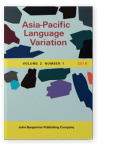James N. Stanford
List of John Benjamins publications for which James N. Stanford plays a role.
Journal
Title
Variation in Indigenous Minority Languages
Edited by James N. Stanford and Dennis R. Preston
[IMPACT: Studies in Language, Culture and Society, 25] 2009. vii, 519 pp.
Subjects Historical linguistics | Sociolinguistics and Dialectology | Theoretical linguistics
2023 Variationist sociolinguistic methods with Indigenous language communities: Commentary on “The Dynamics of Bilingualism in Language Shift Ecologies” by Lenore Grenoble and Boris Osipov Epistemological issue: The dynamics of bilingualism in language shift ecologies, Flores, Cristina and Neal Snape (eds.), pp. 106–111 | Commentary
2019 Variation in the tonal space of Yangliu Lalo, an endangered language of Yunnan, China Linguistics of the Tibeto-Burman Area 42:1, pp. 2–37 | Article
Endangered tone languages are not often studied within quantitative variationist approaches, but such approaches can provide valuable insights for language description and documentation in the Tibeto-Burman area. This study examines tone variation within Yangliu Lalo (Central Ngwi), a minority… read more
2016 Sociotonetics using connected speech: A study of Sui tone variation in free-speech style Asia-Pacific Language Variation 2:1, pp. 48–81 | Article
This is the first variationist sociotonetic study to use free-speech data for exploring tone. Due to the challenges of analyzing tone in free-speech data, prior work on sociotonetics has been limited to relatively formal speech styles: word lists, sentence frames, and phrase lists. But connected… read more
2015 A sociotonetic study of Lalo tone split in progress Asia-Pacific Language Variation 1:1, pp. 52–77 | Article
Since Labov’s early work (e.g., 1963, 1966), sociolinguists have frequently examined change in progress on the segmental level, but much less is known about tone change in progress. The present study finds evidence of a tone split in progress in Lalo, a Tibeto-Burman language of China. While many… read more
2009 20. Clan as a sociolinguistic variable: Three approaches to Sui clans Variation in Indigenous Minority Languages, Stanford, James N. and Dennis R. Preston (eds.), pp. 463–484 | Article
As lesser studied minority languages are added to the purview of quantitative variationist sociolinguistics, we naturally expect to see lesser studied sociolinguistic variables brought to the forefront. One such variable is clan. Among the Sui people of southwest China and in many other societies,… read more
2009 The lure of a distant horizon: Variation in indigenous minority languages Variation in Indigenous Minority Languages, Stanford, James N. and Dennis R. Preston (eds.), pp. 1–20 | Article






